Fujitsu LifeBook T4010, LifeBook T4010D User Guide
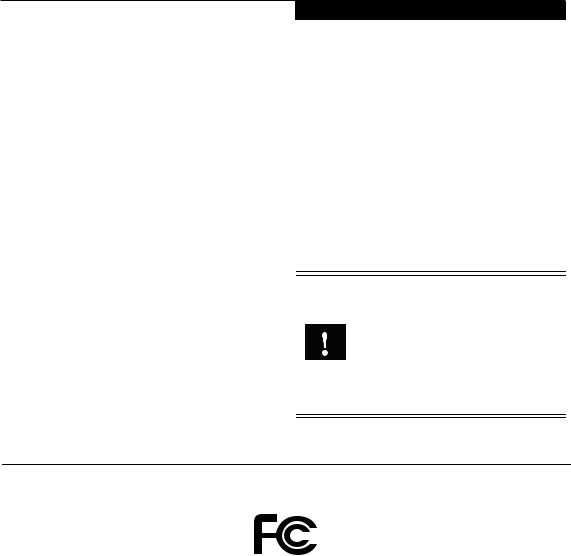
C o p y r i g h t
Copyright & Trademark Information
Fujitsu Computer Systems Corporation has made every effort to ensure the accuracy and completeness of this document. However, as ongoing development efforts are continually improving the capabilities of our products, we cannot guarantee the accuracy of the contents of this document. We disclaim liability for errors, omissions, or future changes.
Fujitsu, the Fujitsu logo, and LifeBook are registered trademarks of Fujitsu Limited.
Microsoft, MS-DOS, and Windows are either registered trademarks or trademarks of Microsoft Corporation in the United States and/or other countries.
PCMCIA is a trademark of the Personal Computer Memory Card International Association.
Intel and Pentium are trademarks or registered trademarks of Intel Corporation or its subsidiaries in the United States and other countries.
Bluetooth is a registered trademark of Bluetooth SIG, Inc.
Adobe, Acrobat, and Acrobat Reader are either registered trademarks or trademarks of Adobe Systems Incorporated in the United States and/or other countries.
All other trademarks mentioned herein are the property of their respective owners.
© Copyright 2004 Fujitsu Computer Systems Corporation. All rights reserved. No part of this publication may be copied, reproduced, or translated, without prior written consent of Fujitsu Computer Systems Corporation. No part of this publication may be stored or transmitted in any electronic form without the written consent of Fujitsu Computer Systems Corporation.
B6FH-3071-02EN-00
WARNING
Handling the cord on this product or cords associated with accessories sold with this product, will expose you to lead, a chemical known to the State of California to cause birth defects or other reproductive harm.
Wash hands after handling.
DECLARATION OF CONFORMITY according to FCC Part 15
Responsible Party Name: |
Fujitsu Computer Systems Corporation |
Address: |
1250 E. Arques Avenue, MS 122 |
|
Sunnyvale, CA 94085 |
Telephone: |
(408) 746-6000 |
Declares that product: |
Model Configuration: |
|
LifeBook T4010 Tablet PC |
|
LifeBook T4010D Tablet PC |
|
Complies with Part 15 of the FCC Rules. |
This device complies with Part 15 of the FCC rules. Operations are subject to the following two conditions:
(1) This device must not be allowed to cause harmful interference, (2) This device must accept any interference received, including interference that may cause undesired operation.
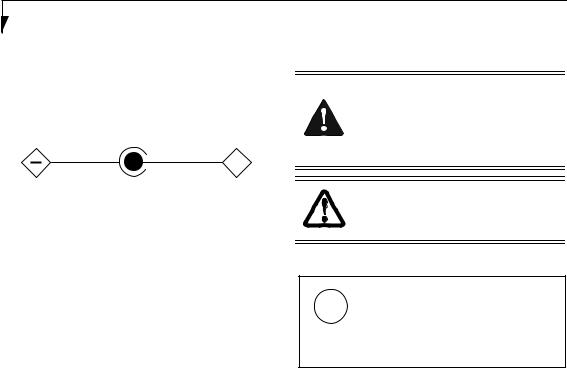
L i f e B o o k T S e r i e s T a b l e t P C
IMPORTANT SAFETY INSTRUCTIONS
This unit requires an AC adapter to operate. Use only UL Listed Adapters with an output rating of 19 VDC, with a current of 3.16 A.
AC Adapter output polarity:
+
When using your notebook equipment, basic safety precautions should always be followed to reduce the risk of fire, electric shock and injury to persons, including the following:
■Do not use this product near water for example, near a bathtub, washbowl, kitchen sink or laundry tub, in a wet basement or near a swimming pool.
■Avoid using the modem during an electrical storm. There may be a remote risk of electric shock from lightning.
■Do not use the modem to report a gas leak in the vicinity of the leak.
■Use only the power cord and batteries indicated in this manual. Do not dispose of batteries in a fire. They may explode. Check with local codes for possible special disposal instructions.
■To reduce the risk of fire, use only No. 26 AWG or larger UL Listed or CSA Certified Telecommunication Line Cord.
SAVE THESE INSTRUCTIONS
For Authorized Repair Technicians Only
Danger of explosion if Lithium (clock) battery is incorrectly replaced. Replace only with the same or equivalent type recommended by the manufacturer. Dispose of used batteries according to the manufacturer’s instruction.
For continued protection against risk of fire, replace only with the same type and rating fuse.
System Disposal
LAMP(S) INSIDE THIS PRODUCT Hg CONTAIN MERCURY AND MUST BE RECYCLED OR DISPOSED OF
ACCORDING TO LOCAL, STATE, OR FEDERAL LAWS.

T a b l e o f C o n t e n t s
Fujitsu LifeBook® T Series Tablet PC
Table of Contents
1
PREFACE
Preface
About This Guide . . . . . . . . . . . . . . . . . . . . . . . . . 3
Fujitsu Contact Information . . . . . . . . . . . . . . . . .3
Warranty . . . . . . . . . . . . . . . . . . . . . . . . . . . . . . . 3
2
GETTING TO KNOW
YOUR TABLET PC
Overview
Unpacking . . . . . . . . . . . . . . . . . . . . . . . . . . . . . .7
Optional Accessories . . . . . . . . . . . . . . . . . . . . . . 8
Locating Controls and Connectors
Top and Front Components . . . . . . . . . . . . . . . . 11
Left-Side Panel Components . . . . . . . . . . . . . . .13
Right-Side Panel Components . . . . . . . . . . . . . .14
Rear Panel Components . . . . . . . . . . . . . . . . . . .15
Bottom Components . . . . . . . . . . . . . . . . . . . . . 16
Status Indicator Panel
Power Indicator . . . . . . . . . . . . . . . . . . . . . . . . . 17
AC Adapter Indicator . . . . . . . . . . . . . . . . . . . . . 17
Battery Charging/Level Indicators. . . . . . . . . . . . 17
Optical Drive Access Indicator . . . . . . . . . . . . . . 18
Hard Drive Access Indicator . . . . . . . . . . . . . . . . 18
NumLk Indicator. . . . . . . . . . . . . . . . . . . . . . . . . 18
CapsLock Indicator . . . . . . . . . . . . . . . . . . . . . . . 18
ScrLk Indicator . . . . . . . . . . . . . . . . . . . . . . . . . . 18
Security Indicator . . . . . . . . . . . . . . . . . . . . . . . .18
Display Panel
Opening the Display Panel . . . . . . . . . . . . . . . . .19
Using the System as a Tablet . . . . . . . . . . . . . . .19
Adjusting Display Panel Brightness . . . . . . . . . . .20
Keyboard
Using the Keyboard . . . . . . . . . . . . . . . . . . . . . .21
Numeric Keypad. . . . . . . . . . . . . . . . . . . . . . . . .21
Windows Keys . . . . . . . . . . . . . . . . . . . . . . . . . .21
Cursor Keys . . . . . . . . . . . . . . . . . . . . . . . . . . . .21
Function Keys. . . . . . . . . . . . . . . . . . . . . . . . . . .22
LifeBook Security/Tablet PC Buttons
Changing Tablet PC Button Functions . . . . . . . .24 Setting up LifeBook Security Panel . . . . . . . . . . .24 Passwords . . . . . . . . . . . . . . . . . . . . . . . . . . . . .24 Using Your LifeBook Security Panel . . . . . . . . . .25 Precautions. . . . . . . . . . . . . . . . . . . . . . . . . . . . .25 Uninstalling the Security Panel Application . . . . .26
Touchpad Pointing Device
Clicking . . . . . . . . . . . . . . . . . . . . . . . . . . . . . . .27
Double-Clicking . . . . . . . . . . . . . . . . . . . . . . . . .27
Dragging . . . . . . . . . . . . . . . . . . . . . . . . . . . . . .28
Scrolling . . . . . . . . . . . . . . . . . . . . . . . . . . . . . . .28
Touchpad Control Adjustment . . . . . . . . . . . . . .28
Volume Control
Controlling the Volume . . . . . . . . . . . . . . . . . . .29
Pen and Active Digitizer
Using the Pen. . . . . . . . . . . . . . . . . . . . . . . . . . .30
Installing a Pen Tether . . . . . . . . . . . . . . . . . . . .30
Calibrating the Pen. . . . . . . . . . . . . . . . . . . . . . .31
Replacing the Pen Tip. . . . . . . . . . . . . . . . . . . . .31
Using the Active Digitizer . . . . . . . . . . . . . . . . . .31

L i f e B o o k T S e r i e s T a b l e t P C
3
USING YOUR TABLET PC
Power Sources
Connecting the Power Adapters. . . . . . . . . . . . . 35
Starting Your Tablet PC
Power On . . . . . . . . . . . . . . . . . . . . . . . . . . . . . 36
Boot Sequence . . . . . . . . . . . . . . . . . . . . . . . . . . 36
BIOS Setup Utility . . . . . . . . . . . . . . . . . . . . . . . 36
Booting the System . . . . . . . . . . . . . . . . . . . . . . 37
Activating Additional Utilities . . . . . . . . . . . . . . . 37
Registering Your Tablet PC. . . . . . . . . . . . . . . . . 37
Power Management
Suspend/Resume Button . . . . . . . . . . . . . . . . . . 38
Standby Mode . . . . . . . . . . . . . . . . . . . . . . . . . . 38
Hibernate Mode. . . . . . . . . . . . . . . . . . . . . . . . . 39
Display Timeout . . . . . . . . . . . . . . . . . . . . . . . . . 39
Hard Disk Timeout . . . . . . . . . . . . . . . . . . . . . . . 39
Windows Power Management . . . . . . . . . . . . . . 39
Restarting the System. . . . . . . . . . . . . . . . . . . . . 39
Power Off . . . . . . . . . . . . . . . . . . . . . . . . . . . . . 40
4
USER-INSTALLABLE FEATURES
Lithium ion Battery
Recharging the Battery. . . . . . . . . . . . . . . . . . . . 43 Replacing the Battery . . . . . . . . . . . . . . . . . . . . . 44
Memory Upgrade Module
Installing Memory Upgrade Modules . . . . . . . . . 45
To Remove a Memory Upgrade Module . . . . . . 45
Checking the Memory Capacity . . . . . . . . . . . . . 46
Flexible Bay Devices
Fujitsu Tablet Controls - CD/DVD Drive Help . . 48
Removing and Installing Modular Devices . . . . . 49
PC Cards
Installing PC Cards . . . . . . . . . . . . . . . . . . . . . . . 50
Removing PC Cards . . . . . . . . . . . . . . . . . . . . . . 50
Smart Card Reader. . . . . . . . . . . . . . . . . . . . . . . 50
Memory Stick/SD Media
Installing/Removing Memory Stick/SD Cards. . . 51
Port Replicator
Rear Panel Components. . . . . . . . . . . . . . . . . . . 52
Front Panel Components . . . . . . . . . . . . . . . . . . 53
Attaching the Port Replicator . . . . . . . . . . . . . . . 54
Detaching the Port Replicator . . . . . . . . . . . . . . 54
Device Ports
Modem (RJ-11) Jack . . . . . . . . . . . . . . . . . . . . . 55 Internal LAN (RJ-45) jack . . . . . . . . . . . . . . . . . . 55 Docking Port . . . . . . . . . . . . . . . . . . . . . . . . . . . 55 Universal Serial Bus Ports . . . . . . . . . . . . . . . . . . 55 IEEE 1394 Port . . . . . . . . . . . . . . . . . . . . . . . . . . 55 Infrared Port . . . . . . . . . . . . . . . . . . . . . . . . . . . 55 Microphone Jack . . . . . . . . . . . . . . . . . . . . . . . . 56 Headphone Jack . . . . . . . . . . . . . . . . . . . . . . . . 56 External Monitor Port . . . . . . . . . . . . . . . . . . . . 56 External DVI Port . . . . . . . . . . . . . . . . . . . . . . . . 56
5
TROUBLESHOOTING
Troubleshooting
Identifying the Problem . . . . . . . . . . . . . . . . . . . 59
Specific Problems . . . . . . . . . . . . . . . . . . . . . . . . 59
Troubleshooting Table . . . . . . . . . . . . . . . . . . . . 60
Power On Self Test Messages . . . . . . . . . . . . . . 67
Modem Result Codes. . . . . . . . . . . . . . . . . . . . . 68
Restoring Your Software
Re-Installing Drivers and Applications . . . . . . . . 69
Restoring the Factory Image . . . . . . . . . . . . . . . 69
6
CARE AND MAINTENANCE
Care and Maintenance
LifeBook T Series Tablet PC . . . . . . . . . . . . . . . . 73
Keyboard . . . . . . . . . . . . . . . . . . . . . . . . . . . . . . 74
Batteries. . . . . . . . . . . . . . . . . . . . . . . . . . . . . . . 74
Optional Floppy Disk Drive and Floppy Disks. . . 74
Optional Optical Drive and Discs . . . . . . . . . . . . 74
PC Cards . . . . . . . . . . . . . . . . . . . . . . . . . . . . . . 75

7
SPECIFICATIONS
Specifications
Configuration Label . . . . . . . . . . . . . . . . . . . . . . 79
Physical Specifications . . . . . . . . . . . . . . . . . . . . 79
Processing Specifications . . . . . . . . . . . . . . . . . . 79
Memory/Storage Specifications . . . . . . . . . . . . . 79
Display Specifications . . . . . . . . . . . . . . . . . . . . .79
Interface Specifications . . . . . . . . . . . . . . . . . . . . 80
Power Specifications. . . . . . . . . . . . . . . . . . . . . . 80
Environmental Specifications . . . . . . . . . . . . . . .80
Agency Approval Specifications . . . . . . . . . . . . . 81
Additional Specifications. . . . . . . . . . . . . . . . . . . 81
Regulatory Information . . . . . . . . . . . . . . . . . . .82
8
GLOSSARY
Glossary . . . . . . . . . . . . . . . . . . . . . . . . . . . . . . .87
APPENDIX A: INTEGRATED WIRELESS LAN USER’S GUIDE
FCC Regulatory Information . . . . . . . . . . . . . . .95
Before Using the Wireless LAN
Wireless LAN Modes Using this Device. . . . . . . . 96 Wireless Network Considerations . . . . . . . . . . . . 97 Deactivating the WLAN Device . . . . . . . . . . . . .98 Activating the WLAN Device . . . . . . . . . . . . . . . 98
T a b l e o f C o n t e n t s
Configuration of the WLAN Device
Flow of Operations. . . . . . . . . . . . . . . . . . . . . . .99 Configuration Using Zero Configuration Tool . . .99 Configuration Using Intel PROSet Software . . .100 Configuration Using Atheros Client Utility . . . .101 Connection to the network. . . . . . . . . . . . . . . .103
Troubleshooting the WLAN
Troubleshooting . . . . . . . . . . . . . . . . . . . . . . . .106
Wireless LAN Glossary
Glossary . . . . . . . . . . . . . . . . . . . . . . . . . . . . . .107
IP address information
Additional Information . . . . . . . . . . . . . . . . . . .109
Specifications
Specification . . . . . . . . . . . . . . . . . . . . . . . . . . .110
Using the Bluetooth Device
What is Bluetooth?. . . . . . . . . . . . . . . . . . . . . .111 Installing Bluetooth. . . . . . . . . . . . . . . . . . . . . .111 Where to Find Information About Bluetooth . .111
Index
Index . . . . . . . . . . . . . . . . . . . . . . . . . . . . . . . .113

L i f e B o o k T S e r i e s T a b l e t P C

1
Preface
1

L i f e B o o k T S e r i e s T a b l e t P C
2
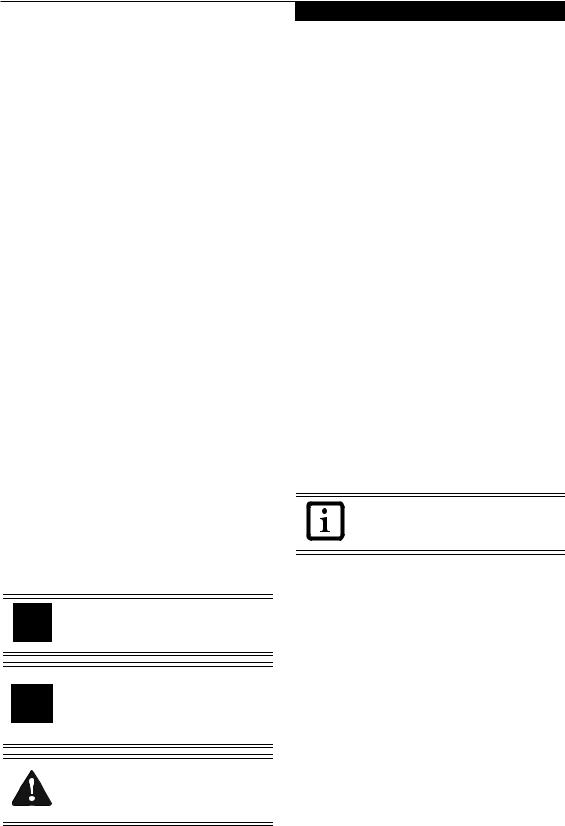
Preface
ABOUT THIS GUIDE
The LifeBook® T Series Tablet PC from Fujitsu Computer Systems Corporation is a powerful convertible computer. It can be used either as a standard notebook using keyboard input, or in tablet configuration using pen input. It is powered by an Intel® microprocessor, has a built-in color display with an active digitizer, and brings the computing power of desktop personal computers (PCs) to a portable and versatile environment.
This manual explains how to operate your LifeBook T Series Tablet PC’s hardware and built-in system software. Your LifeBook T Series Tablet PC comes with Windows® XP Tablet PC Edition pre-installed.
Your LifeBook T Series Tablet PC is a completely selfcontained unit with an active-matrix (TFT) color LCD display. The display has a wide viewing angle and can be used indoors or outdoors. The tablet has a powerful interface that enables it to support a variety of optional features.
Conventions Used in the Guide
Keyboard keys appear in brackets.
Example: [Fn], [F1], [Esc], [Enter] and [Ctrl].
Pages with additional information about a specific topic are cross-referenced within the text.
Example: (See page xx.)
On screen buttons or menu items appear in bold. Example: Click OK to restart your Tablet PC.
DOS commands you enter appear in Courier type. Example: Shutdown the computer?
The information icon highlights information that will enhance your understanding of the subject material.
The caution icon highlights information that is important to the safe operation of your computer, or to the integrity of your files. Please read all caution information carefully.
The warning icon warns you about possible hazards that can occur to you, your system, or your files. Please read all warning information carefully.
P r e f a c e
FUJITSU CONTACT INFORMATION
Service and Support
You can contact Fujitsu Computer Systems Service and Support the following ways:
■Toll free: 1-800-8Fujitsu (1-800-838-5487)
■Fax: 1-408-764-2724
■E-mail: 8fujitsu@us.fujitsu.com
■Web site: http://www.computers.us.fujitsu.com/support
Before you place the call, you should have the following information ready so that the customer support representative can provide you with the fastest possible solution:
■Product name
■Product configuration number
■Product serial number
■Purchase date
■Conditions under which the problem occurred
■Any error messages that have occurred
■Type of device connected, if any
Fujitsu Online
You can go directly to the online Fujitsu Product catalog for your Tablet PC. Go to Start -> Fujitsu WebLinks -> Pen Accessories Web site.
You can also reach Fujitsu Service and Support online by going to Start -> Fujitsu WebLinks -> Fujitsu Service and Support.
You must have an active internet connection to use the online URL links.
WARRANTY
Your LifeBook T Series Tablet PC is backed by an International Limited Warranty and includes toll-free technical support. Check the service kit that came with your Tablet PC for warranty terms and conditions.
3

L i f e B o o k T S e r i e s T a b l e t P C - P r e f a c e
4

2
Getting to Know Your Tablet PC
5

L i f e B o o k T S e r i e s T a b l e t P C
6
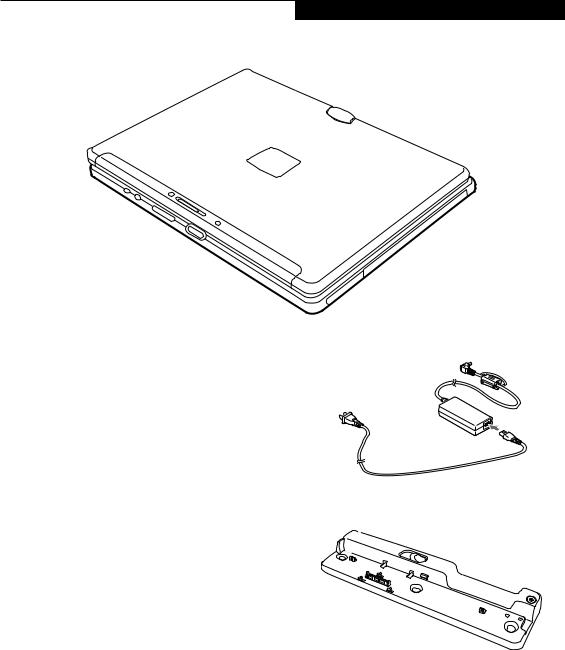
G e t t i n g t o K n o w Y o u r T a b l e t P C
Figure 2-1. Fujitsu LifeBook T Series Tablet PC
Overview
This section describes the components of your Fujitsu LifeBook T Series Tablet PC. We strongly recommend that you read it before using your Tablet PC, even if you are already familiar with mobile computers.
UNPACKING
When you receive your LifeBook T Series Tablet PC,
unpack it carefully, and compare the parts you have Figure 2-2. AC Adapter received with the items listed below.
For a pre-configured model you should have:
■ |
LifeBook T Series Tablet PC (Figure 2-1) |
|
|
■ |
AC adapter with AC power cord (Figure 2-2) |
|
|
■ |
Phone/Modem (RJ-11) telephone cable |
|
|
■ |
Pen |
|
|
■ |
Pen tether |
|
|
■ |
Screen protectors (Qty. 2) |
|
|
■ |
Driver and Application Restore (DAR) CD |
|
|
■ |
Recovery DVD |
Figure 2-3. Optional Port Replicator |
|
■ |
Getting Started Guide |
||
|
|||
■ |
User’s Guide (this document) |
|
|
■ |
International Limited Warranty Booklet |
|
|
■ |
Certificate of Authenticity |
|
|
■ |
Lithium ion battery (pre-installed) |
|
You may also have one or more of the following devices in the box, depending upon the configuration of your system:
■Port Replicator (Figure 2-3)
■External USB Floppy Disk Drive
■Additional battery(s)
■Application CD(s) for third-party software
7

L i f e B o o k T S e r i e s T a b l e t P C - S e c t i o n 2
OPTIONAL ACCESSORIES
The following optional accessories can be used with the LifeBook T Series Tablet PC. Refer to the instructions provided with these accessories for details on their use. For the latest list of accessories available for your LifeBook T Series Tablet PC, be sure to frequently check the Fujitsu Web site at: us.fujitsu.com/computers
Docking Options |
Power Options |
||
■ |
LifeBook T Series Tablet PC port replicator |
■ |
AC Adapter with US cord |
Carrying Cases |
■ |
Main battery |
|
■ |
Executive leather portfolio |
■ |
Modular bay battery |
■ |
Field Mate convertible |
■ |
Auto/airline adapter |
■ |
Duo Travel Bag |
■ |
Battery charger with AC Adapter |
■ |
Director leather carrying case |
Input Accessories |
|
■ |
Diplomat carrying case |
■ |
Replacement pen set (2-pack) |
■ |
Backpack |
■ |
USB optical mouse |
Storage Options |
Additional Accessories |
||
■ |
External USB floppy disk drive |
■ |
4-in-1 PC Card Adapter |
■ |
Modular DVD/CD-RW Combo Drive |
■ |
Compact Flash card adapter |
■ |
Multi-Format DVD Writer |
■ |
Notebook Guardian Lock |
Memory |
■ |
Screen protectors |
|
■ |
256 MB SDRAM, DDR333 |
■ |
Deluxe pen tether |
■512 MB SDRAM, DDR333
■1.0 GB SDRAM, DDR333
■128 MB Compact Flash card
■256 MB Compact Flash card
■128 MB Secure Digital memory card
8
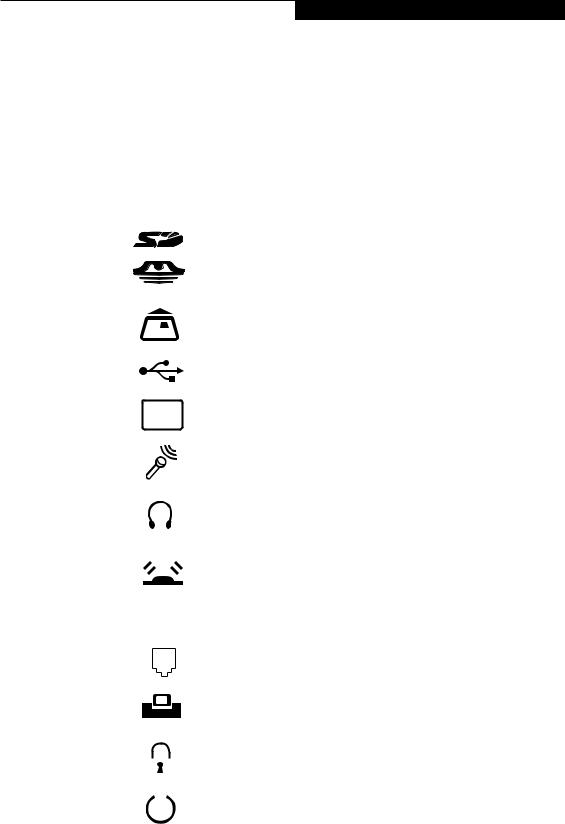
G e t t i n g t o K n o w Y o u r T a b l e t P C
Locating the Controls and Connectors
Connectors and peripheral interfaces on the LifeBook T Series Tablet PC and the optional port replicator allow you to connect a variety of devices. Specific locations are illustrated in Figures 2-4 through 2-8. The table below
provides a short description of each icon on the LifeBook T Series Tablet PC. Each of the icons is either molded into or printed on the Tablet PC chassis.
Connection |
|
Tablet PC |
Purpose |
||||||||||
|
|
|
Icon |
||||||||||
|
|
|
|
|
|||||||||
|
|
|
|
|
|
|
|
|
|
|
|
|
|
DC in connector |
|
|
|
|
|
|
|
|
|
|
|
|
Connect an external power source such as the AC adapter or auto/ |
|
|
|
|
|
|
|
|
|
|
|
|
||
|
|
|
|
|
|
|
|
|
|
|
|
|
airline adapter. |
|
|
|
|
|
|
|
|
|
|
|
|
|
|
|
|
|
|
|
|
|
|
|
|
|
|
|
|
SD/Memory |
|
|
|
|
|
|
|
|
|
|
|
|
The Secure Digital (SD) card/Memory Stick slot allows you to install |
Stick Slot |
|
|
|
|
|
|
|
|
|
|
|
|
|
|
|
|
|
|
|
|
|
|
|
|
|
a flash memory card for data storage. Flash memory cards allow |
|
|
|
|
|
|
|
|
|
|
|
|
|
|
|
|
|
|
|
|
|
|
|
|
|
|
|
|
you to transfer data to and from a variety of different digital |
|
|
|
|
|
|
|
|
|
|
|
|
|
devices. |
|
|
|
|
|
|
|
|
|
|
|
|
|
|
Smart Card Slot |
|
|
|
|
|
|
|
|
|
|
|
|
The dedicated Smart Card slot allows you to install a Smart Card on |
|
|
|
|
|
|
|
|
|
|
|
|
|
which you can store such data as medical information or electronic |
|
|
|
|
|
|
|
|
|
|
|
|
|
“cash”. |
|
|
|
|
|
|
|
|
|
|
|
|
|
|
USB Port |
|
|
|
|
|
|
|
|
|
|
|
|
Connect Universal Serial Bus 2.0 or 1.1 compliant devices to the |
|
|
|
|
|
|
|
|
|
|
|
|
|
Tablet PC. |
|
|
|
|
|
|
|
|
|
|
|
|
|
|
PCMCIA Card slot |
|
|
|
|
|
|
|
|
|
|
|
|
Install Type I, Type II, or Type III PC Cards. |
|
|
|
|
|
|
|
|
|
|
|
|
|
|
|
|
|
|
|
|
|
|
|
|
|
|
|
|
|
|
|
|
|
|
|
|
|
|
|
|
|
|
|
|
|
|
|
|
|
|
|
|
|
|
|
|
Microphone jack |
|
|
|
|
|
|
|
|
|
|
|
|
Connect an external microphone. The internal microphone is |
|
|
|
|
|
|
|
|
|
|
|
|
|
disabled when you plug in an external microphone. |
|
|
|
|
|
|
|
|
|
|
|
|
|
|
Headphone jack |
|
|
|
|
|
|
|
|
|
|
|
|
Connect stereo headphones or powered external speakers. The |
|
|
|
|
|
|
|
|
|
|
|
|
|
internal speaker is disabled when you plug in external headphones |
|
|
|
|
|
|
|
|
|
|
|
|
|
or powered speakers. |
|
|
|
|
|
|
|
|
|
|
|
|
|
|
IrDA/FIR port |
|
|
|
|
|
|
|
|
|
|
|
|
An infrared transceiver built into the Tablet PC allows you to |
|
|
|
|
|
|
|
|
|
|
|
|
|
communicate with other devices that are compliant with IrDA |
|
|
|
|
|
|
|
|
|
|
|
|
|
|
|
|
|
|
|
|
|
|
|
|
|
|
|
Standard Rev. 1.1. Effective range for infrared communication is |
|
|
|
|
|
|
|
|
|
|
|
|
|
about 3 feet, and within 15 degrees off center. A clear line-of-sight |
|
|
|
|
|
|
|
|
|
|
|
|
|
path must exist between the IrDA port on the computer and the |
|
|
|
|
|
|
|
|
|
|
|
|
|
IrDA transceiver on the other device. |
|
|
|
|
|
|
|
|
|
|
|
|
|
|
Modem |
|
|
|
|
|
|
|
|
|
|
|
|
Connect a telephone line to the internal modem using a standard |
|
|
|
|
|
|
|
|
|
|
|
|
|
RJ-11 telephone plug. |
|
|
|
|
|
|
|
|
|
|
|
|
|
|
Tablet Dock port |
|
|
|
|
|
|
|
|
|
|
|
|
Connect the Tablet PC port replicator or other approved docking |
|
|
|
|
|
|
|
|
|
|
|
|
|
device. Refer to documentation accompanying the dock for more |
|
|
|
|
|
|
|
|
|
|
|
|
|
information. |
|
|
|
|
|
|
|
|
|
|
|
|
|
|
Security lock slot |
|
|
|
|
|
|
|
|
|
|
|
|
The security slot allows you to secure the Tablet PC using |
|
|
|
|
|
|
|
|
|
|
|
|
|
Kensington-compatible locking devices. |
|
|
|
|
|
|
|
|
|
|
|
|
|
|
|
|
|
|
|
|
|
|
|
|
|
|
|
|
|
|
|
|
|
|
|
|
|
|
|
|
|
|
Suspend/Resume |
|
|
|
|
|
|
|
|
|
|
|
|
The Suspend/Resume button allows you to suspend Tablet PC |
|
|
|
|
|
|
|
|
|
|
|
|
||
button |
|
|
|
|
|
|
|
|
|
|
|
|
activity without powering off, resume your Tablet PC from suspend |
|
|
|
|
|
|
|
|
|
|
|
|
||
|
|
|
|
|
|
|
|
|
|
|
|
|
mode, and power on the system when it has been shut down from |
|
|
|
|
|
|
|
|
|
|
|
|
|
Windows. |
|
|
|
|
|
|
|
|
|
|
|
|
|
|
9
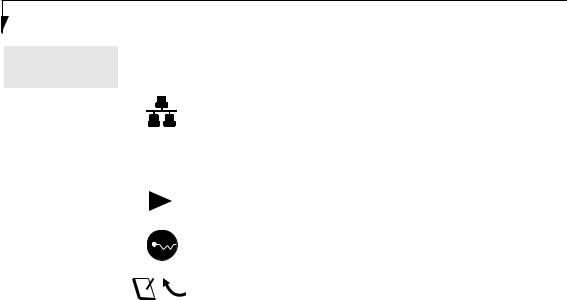
L i f e B o o k T S e r i e s T a b l e t P C - S e c t i o n 2
Connection |
Tablet PC |
Purpose |
||||||||
|
Icon |
|||||||||
|
|
|
||||||||
|
|
|
|
|
|
|
|
|
|
|
Local Area |
|
|
|
|
|
|
|
|
|
The LAN (RJ-45) jack is used to connect the internal 10/100/1000* |
|
|
|
|
|
|
|
|
|
||
Network (LAN) |
|
|
|
|
|
|
|
|
|
Base-T/Tx Ethernet to a Local Area Network (LAN) in your office or |
|
|
|
|
|
|
|
|
|
||
|
|
|
|
|
|
|
|
|
||
|
|
|
|
|
|
|
|
|
||
|
|
|
|
|
|
|
|
|
|
home, or broadband devices such as a cable modem, DSL, or satellite |
|
|
|
|
|
|
|
|
|
|
|
|
|
|
|
|
|
|
|
|
|
|
|
|
|
|
|
|
|
|
|
|
Internet. |
|
|
|
|
|
|
|
|
|
|
*1000 Mbps, commonly referred to as Gigabit Ethernet. |
|
|
|
|
|
|
|
|
|
|
|
Battery Release |
|
|
|
|
|
|
|
|
|
The battery release latch allows you to remove the battery from |
Latch |
|
|
|
|
|
|
|
|
|
your system for storage or replacement. |
|
|
|
|
|
|
|
|
|
|
|
Wireless LAN |
|
|
|
|
|
|
|
|
|
The wireless LAN switch allows you to turn power to the optional |
On-Off Switch |
|
|
|
|
|
|
|
|
|
wireless LAN device on and off. |
|
|
|
|
|
|
|
|
|
|
|
Display Rotation |
|
|
|
|
|
|
|
|
|
This icon indicates the direction in which the display should be |
|
|
|
|
|
|
|
|
|
|
rotated when converting to tablet mode. |
|
|
|
|
|
|
|
|
|
|
|
|
|
|
|
|
|
|
|
|
|
Table 2-1. System icons |
10
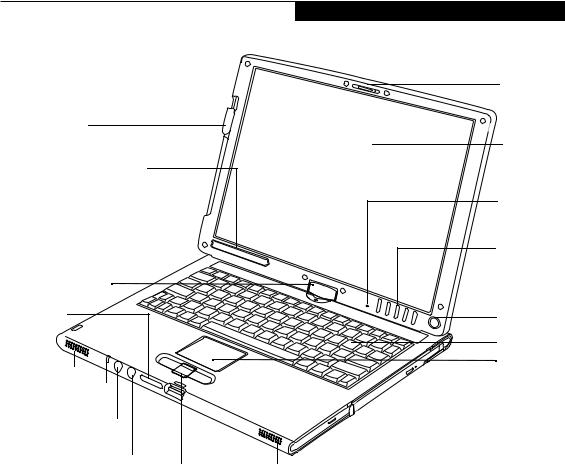
G e t t i n g t o K n o w Y o u r T a b l e t P C
Display
Built-in Microphone 
 Panel
Panel
Latch
Pen/ |
|
|
Pen Holder |
|
Display |
|
|
|
Status |
|
Panel |
|
|
|
Indicator |
|
|
Panel |
|
Built-in |
|
|
|
|
|
Microphone |
|
|
LifeBook |
|
|
Security/ |
|
|
Tablet PC |
Rotation |
|
Buttons |
|
|
|
Hinge |
|
Suspend/ |
SD/Memory |
|
|
|
Resume |
|
Stick Slot |
|
Button |
|
|
Keyboard |
Stereo Speaker |
|
Touchpad |
|
Pointing |
|
Power |
|
|
|
Device |
|
Indicator |
|
|
Headphone |
|
|
Jack |
|
|
Microphone |
Scroll Button |
|
Jack |
Stereo Speaker |
Figure 2-4. LifeBook T Series Tablet PC with display open
TOP AND FRONT COMPONENTS
The following is a brief description of the top and front features of the LifeBook T Series Tablet PC. (Figure 2-4)
Pen/Pen Holder
The pen is used as the interface with the active digitizer display.
Display Panel Latch
The display panel latch locks and releases the display panel.
Display Panel
The display panel is a color LCD panel with back lighting for the display of text and graphics and active digitizer functionality.
Built-in Microphones
The built-in microphones allow you to input mono audio.
LifeBook Security/Tablet PC Buttons
The LifeBook T Series Tablet PC Security/Tablet PC Buttons provide hardware security and application launch capabilities. See “LifeBook Security/ Tablet PC Buttons” on page 23.
Suspend/Resume Button
The Suspend/Resume button allows you to suspend Tablet PC activity without powering off, resume your Tablet PC from standby mode, and power on your system when it has been shut down from the Windows operating system. See “Power On” on page 36.
Keyboard
A full-function keyboard with dedicated Windows keys. See “Keyboard” on page 21.
Touchpad Pointing Device
The Touchpad pointing device consists of two mouselike buttons and one scroll button. See “Touchpad Pointing Device” on page 27.
Stereo Speakers
The stereo speakers allow you to listen to stereo sound from your system.
Microphone Jack
The microphone jack allows you to connect an external mono microphone. See “Microphone Jack” on page 56.
11

L i f e B o o k T S e r i e s T a b l e t P C - S e c t i o n 2
Headphone Jack
The headphone jack allows you to connect headphones or powered external speakers. See “Headphone Jack” on page 56.
Power Indicator
The power indicator shows the power state of the system. Solid green indicates that power is on, and blinking green indicates that the system is in suspend mode.
SD Card/Memory Stick
The Secure Digital (SD) card/Memory Stick slot allows you to install a flash memory card for data storage. Flash memory cards allow you to transfer data to and from a variety of different digital devices.
Rotation Hinge
The rotation hinge allows you to transform your Tablet PC from a notebook configuration into a tablet configuration. See “Using the System as a Tablet” on page 19.
Status Indicator Panel
The Status Indicator Panel displays symbols that correspond to specific components of your LifeBook T Series Tablet PC. See “Status Indicator Panel” on page 17.
12

G e t t i n g t o K n o w Y o u r T a b l e t P C
Pen Tether Attachment Point |
USB 2.0 Port |
PC Card Slot |
Air Vents |
Wireless/Bluetooth LAN |
IEEE 1394 Port |
Smart Card Slot |
PC Card Eject/ |
|
On/Off Switch |
|
|
Lock Button |
|
|
|
|
Figure 2-5. LifeBook T Series Tablet PC left-side panel
LEFT-SIDE PANEL COMPONENTS
Following is a brief description of your Tablet PC’s leftside components. (Figure 2-5)
Pen Tether Attachment Point
The pen tether attachment point is designed to securely hold a pen tether to prevent loss of the pen. See “Installing a Pen Tether” on page 30 for additional information.
USB 2.0 Port
The USB 2.0 port allow you to connect Universal Serial Bus devices. See “Universal Serial Bus Ports” on page 55.
PC Card Slot
The PC Card Slot allows you to install a Type I or Type II PC Card. The PC Card Eject Button is used when
ejecting a PC Card from the slot. See “PC Cards” on page 50.
IEEE 1394 Port
Allows you to connect IEEE 1394 (Firewire) peripherals such as digital video cameras or external hard drives to your Tablet PC.
WLAN/Bluetooth On/Off Switch
The wireless LAN/Bluetooth On/Off Switch is used to power off the wireless antenna when not in use.
Smart Card Slot
The dedicated Smart Card slot allows you to install an optional Smart Card on which you can store such data as medical information or electronic “cash”.
13
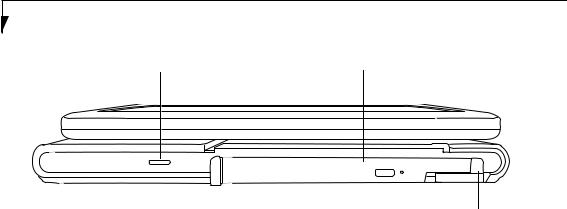
L i f e B o o k T S e r i e s T a b l e t P C - S e c t i o n 2
Anti-theft Lock Slot Flexible Bay
Flexible Bay Eject Lever
Figure 2-6. LifeBook T Series Tablet PC right-side panel
RIGHT-SIDE PANEL COMPONENTS
Following is a brief description of your Tablet PC’s rightside components.
Flexible Bay
The Flexible Bay can accommodate one of the following devices. See “Flexible Bay Devices” on page 48.
■Modular DVD/CD-RW combo drive
■Modular Multi-Format DVD Writer
■Modular DVD-ROM drive
■Modular Lithium ion battery
■Weight Saver
Flexible Bay Eject Lever
The Flexible Bay eject lever releases the Flexible Bay device.
Anti-theft Lock Slot
The anti-theft lock slot allows you to attach a optional physical lock-down device.
14
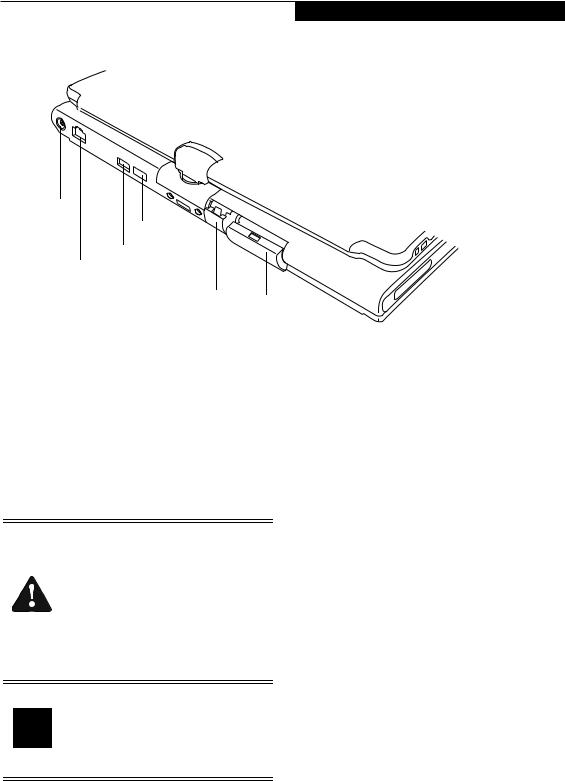
G e t t i n g t o K n o w Y o u r T a b l e t P C
DC |
|
|
Power |
Infrared Port |
|
Jack |
||
|
USB 2.0 Port
Modem (RJ-11) Port
LAN (RJ-45) Port |
External |
|
|
|
Monitor Port |
Figure 2-7. LifeBook T Series Tablet PC rear panel
REAR PANEL COMPONENTS
DC Power Jack
The DC power jack allows you to plug in the AC adapter or the optional Auto/Airline adapter to power your Tablet PC and charge the internal Lithium ion Battery.
Modem (RJ-11) Telephone Port
The Modem (RJ-11) telephone port is for attaching a telephone line to the internal multinational 56K modem.
The internal multinational modem is not intended for use with Digital PBX systems. Do not connect the internal modem to a Digital PBX as it may cause serious damage to the internal modem or your entire LifeBook T Series Tablet PC. Consult your PBX manufacturer’s documentation for details. Some hotels have Digital PBX systems. Be sure to find out BEFORE you connect your modem.
The internal modem is designed to the ITU-T V.90 standard. Its maximum speed of 53000 bps is the highest allowed by FCC, and its actual connection rate depends on the line conditions. The maximum speed is 33600 bps at upload.
USB 2.0 Ports
The two USB 2.0 ports allow you to connect Universal Serial Bus devices. See “Universal Serial Bus Ports” on page 55.
Infrared Port
The fast IrDA compatible port allows you to communicate with another IrDA-compatible infrared device without a cable. (See “Infrared Port” on page 55.)
LAN (RJ-45) Port
The internal LAN (RJ-45) port is used for an internal GigaLAN Ethernet (10/100/1000 Base-T/TX) connection. See “Internal LAN (RJ-45) jack” on page 55.
External Monitor Port
The external monitor port allows you to connect an external VGA or SVGA CRT monitor. Note that when the optional Port Replicator is attached to the system, you must use the external monitor port on the Port Replicator rather than the port on the system. See “External Monitor Port” on page 56.
15
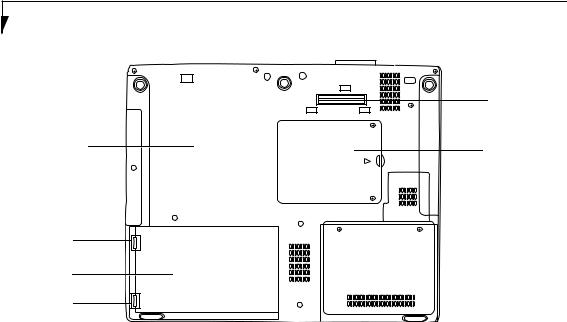
L i f e B o o k T S e r i e s T a b l e t P C - S e c t i o n 2
|
Port Replicator |
|
Connector |
Main Unit and |
|
Configuration |
Memory |
Label (approximate |
Upgrade |
location) |
Compartment |
Battery
Pack
Latch
Lithium ion
Battery
Compartment
Battery
Pack
Latch
Figure 2-8. LifeBook T Series Tablet PC bottom panel
BOTTOM COMPONENTS
Following is a brief description of your Tablet PC’s bottom panel components. (Figure 2-8)
Lithium ion Battery Compartment
The battery compartment contains the internal Lithium ion battery. The battery should be removed when the computer is stored over a long period of time or for swapping a discharged battery with a charged Lithium ion battery. See “Lithium ion Battery” on page 43.
Port Replicator Connector
This connector allows you to connect the optional port replicator.
Main Unit and Configuration Label
The configuration label shows the model number and other information about your LifeBook T Series Tablet PC. In addition, the configuration portion of the label has the serial number and manufacturer information that you will need to give your support representative. It identifies the exact version of various components of your Tablet PC.
Memory Upgrade Compartment
Your Tablet PC comes with high speed Synchronous Dynamic RAM (SDRAM). The memory upgrade compartment allows you to expand the system memory capacity of your Tablet PC, hence improving overall performance. See “Memory Upgrade Module” on
page 45.
16
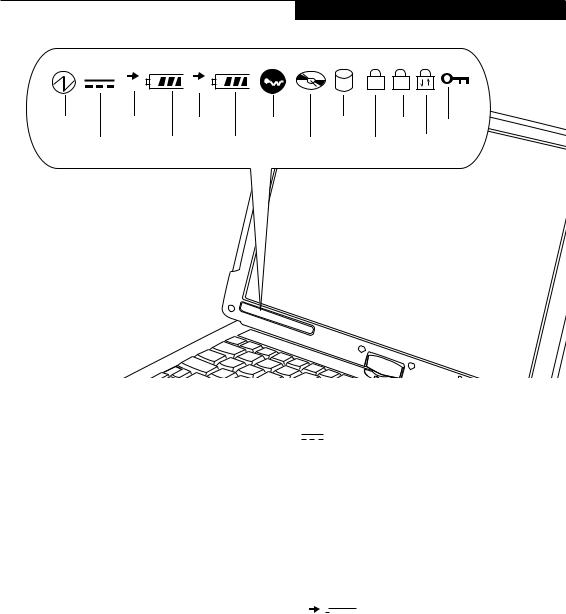
G e t t i n g t o K n o w Y o u r T a b l e t P C
|
1 |
|
2 |
|
|
1 |
|
A |
|
|
|
|
|
|
|
|
|
||
Power |
Battery 1 |
Battery 2 |
Wireless |
|
Hard Drive |
CapsLk |
Security |
||
|
Charging |
Charging |
LAN Access |
Access |
|
ScrLk Indicator |
|||
AC Adapter |
Battery 1 |
Battery 2 |
Optical |
NumLk |
|||||
|
|
Level |
Level |
|
Drive Access |
|
|
|
|
Figure 2-9. Status Indicator Panel
Status Indicator Panel
AC ADAPTER INDICATOR
The Status Indicator Panel displays symbols that correspond to specific components of your LifeBook T Series Tablet PC. These symbols tell you how each of those components is operating. (Figure 2-9)
 POWER INDICATOR
POWER INDICATOR
The Power indicator symbol states whether your system is operational. It has several different states, each of which tells you what mode your Tablet PC is in at that time.
■Steady On: This means that there is power to your Tablet PC and that it is ready for use.
■Flashing: This means that your Tablet PC is in Standby mode.
■Steady Off: This means that your system is either in Hibernate mode, or that your Tablet PC has been turned off.
If you are charging your battery, the Power indicator symbol will remain on even if your LifeBook T Series Tablet PC is shut off. The Power indicator symbol will also remain on if you have either adapter connected and are shut down from Windows.
The AC adapter indicator states whether your tablet is operating from the AC adapter, the auto/airline adapter or the batteries. This icon has two different states that can tell you what power source your LifeBook Tablet PC is using.
■On: This means that either of the adapters are currently in use.
■Off: Power is only coming from the batteries, and you do not have an adapter connected.
1 

 BATTERY CHARGING/ LEVEL INDICATORS
BATTERY CHARGING/ LEVEL INDICATORS
The Battery Charging and Battery Level indicators state whether the Lithium ion battery (Battery 1) or the optional modular battery (Battery 2) are installed and charging, and how much charge is available within the batteries. (Figure 2-10)
Additionally, these indicators display when an overcurrent is detected. If an overcurrent is detected, the battery stops charging and the Battery Level indicator blinks at the rate of once per second. To stop the indicator from blinking, you must disconnect the power adapter.
17

L i f e B o o k T S e r i e s T a b l e t P C - S e c t i o n T w o
Batteries subjected to shocks, vibration or extreme temperatures can be permanently damaged.
 76%–100% Charging
76%–100% Charging
76%–100%
51%–75%
26%–50%
11%–25%
 Low Warning <11%
Low Warning <11%
Critical Low or
Dead Battery
 Shorted Battery
Shorted Battery
Figure 2-10. Battery Level Indicator
A shorted battery is damaged and must be replaced.
If there is no battery activity and the power adapters are not connected, the Battery Level indicators will also be off.
 WIRELESS LAN ACCESS INDICATOR
WIRELESS LAN ACCESS INDICATOR
The Wireless LAN Access indicator is displayed when the optional internal wireless LAN device is being accessed.
 OPTICAL DRIVE ACCESS INDICATOR
OPTICAL DRIVE ACCESS INDICATOR
The Optical Drive Access indicator states whether your internal optical drive is being accessed.
 HARD DRIVE ACCESS INDICATOR
HARD DRIVE ACCESS INDICATOR
The Hard Drive Access indicator states whether your internal hard drive is being accessed.
NUMLK INDICATOR
The NumLk indicator states that the integral keyboard is set in ten-key numeric keypad mode.
If there is no battery activity and the power adapters are not connected, the Battery Level indicators will also be off.
CAPSLOCK INDICATOR
The CapsLock indicator states that your keyboard is set to type in all capital letters.
SCRLK INDICATOR
The ScrLk indicator states that your scroll lock is active.
SECURITY INDICATOR
The Security Indicator flashes (if a password was set) when the system resumes from Off or Standby modes. You must enter the password that was set in the Security Panel before your system will resume operation.
18
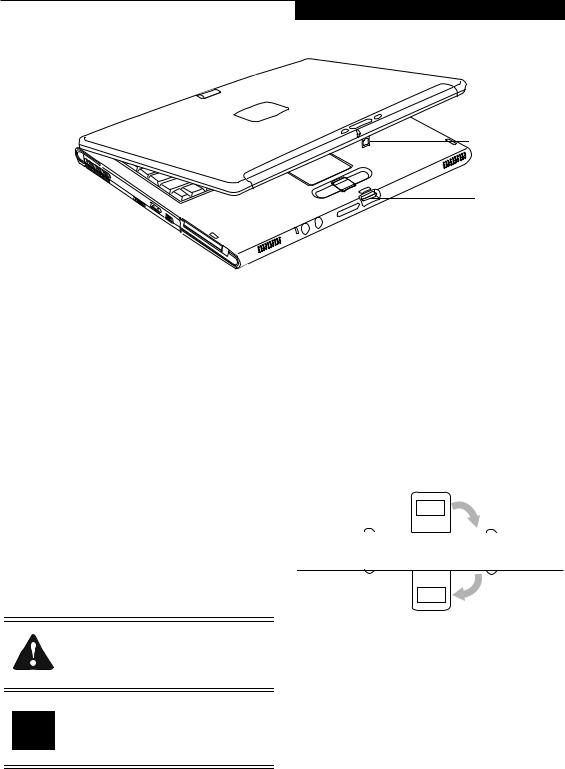
G e t t i n g t o K n o w Y o u r T a b l e t P C
Display
Panel
Latch
Latch
Release
Button
Figure 2-11. Opening the display
Display Panel
Your LifeBook T Series Tablet PC contains a display panel that is backlit for easier viewing in bright environments. The convertible design of your Tablet PC allows you to open the display fully, rotate it 180 degrees, and lay it face up on the keyboard. This allows you to use the system as a tablet, much as you would a pad of paper.
OPENING THE DISPLAY PANEL
1.Press the latch release button. This releases the locking mechanism. While holding the latch release, lift display cover.
2.Lift the display backwards, being careful not to touch the screen, until it is at a comfortable viewing angle. (Figure 2-11)
USING THE SYSTEM AS A TABLET
If you would like to use the system as a tablet, perform the following steps.
Rotate the system display only in the direction indicated in the procedure.
Turning the display in the incorrect direction could cause hinge damage.
In the following step, be sure to position the display perpendicular to the keyboard, otherwise the keyboard or display cover could get scratched.
(Figure 2-14). Turn the display 180 degrees so that it is facing backwards. (Figure 2-15)
3.Holding the top edge of the display panel, pull it forward until it is lying nearly atop the keyboard.
4.Push the latch towards the display (See “A” in Figure 2-12). The latch will pivot so the top latch disappears, and the bottom latch appears (See “B” in Figure 2-12). Holding the latch down, lay the display flush against the system so that the latch engages. You can now use your system as a tablet. (Figure 2- 16)
|
A |
|
Top latch |
Display Side |
|
|
|
|
|
|
|
|
|
|
Bottom latch
B
Figure 2-12. Latching/Unlatching
5.To return the system to notebook configuration, repeat step 3 and 2. Be sure to turn the display in the opposite direction when performing step 2.
1.Lift the display until it is perpendicular to the keyboard. (Figure 2-13).
2.When the display is perpendicular to the keyboard, rotate it clockwise (when viewed from the top). Be very careful to rotate it in the direction indicated.
19

L i f e B o o k T S e r i e s T a b l e t P C - S e c t i o n T w o
90o
Figure 2-13. Fully open display
Figure 2-14. Rotating the display
Figure 2-15. Display rotated completely
Figure 2-16. System in tablet configuration
ADJUSTING DISPLAY PANEL BRIGHTNESS
Once you have turned on your Tablet PC, you may want to adjust the brightness level of the screen to a more comfortable viewing level. There are two ways to adjust the brightness, keyboard and power management utility.
Using Keyboard to Adjust Brightness
Adjusting the brightness using the keyboard changes the system setting (i.e., the settings you make via the function keys automatically changes the brightness settings in the system’s Pen and Tablet Settings).
■[Fn+F6]: Pressing repeatedly will lower the brightness of your display.
■[Fn+F7]: Pressing repeatedly will increase the brightness of the display.
Using Power Management to Adjust Brightness
To adjust brightness with the power management utility, click Start -> Control Panel -> Tablet and Pen Settings. Select the Display tab and set the screen brightness slider for battery and AC power scenarios.
Using the Fujitsu Menu to Adjust Brightness
To adjust brightness using the Fujitsu menu, click on the Fujitsu Menu icon in the system tray in the lower right corner of the screen (or double-click the Function button). From the menu that appears, select Brightness Control. The Tablet and Pen Settings window will open. Select the Display tab and set the screen brightness slider for battery and AC power scenarios.
If using AC power your brightness setting is set to its highest level by default. If using battery power your brightness settings is set to approximately mid-level by default.
The higher the brightness level, the more power the LifeBook T Series Tablet PC will consume and the faster your batteries will discharge. For maximum battery life, make sure that the brightness is set as low as possible.
20

G e t t i n g t o K n o w Y o u r T a b l e t P C
Function Keys
Home |
End |
|
|
|
Numeric Keypad |
|
|
|
|
|
|
|
|
|
|
|
|
|
|
|
(outlined with thick |
|
|
|
|
Fn Key Start Key |
|
|
|
|
|||
black line) |
Application Key |
Cursor Keys |
|||||
|
|
|
|
||||
|
|
|
Figure 2-17. Keyboard |
|
|
|
|
Keyboard
USING THE KEYBOARD
Your LifeBook T Series Tablet PC has an integral 84-key keyboard. The keys perform all the standard functions of a 101-key keyboard, including the Windows keys and other special function keys. This section describes the following keys. (Figure 2-17)
■Numeric keypad: Your Tablet PC allows certain keys to serve dual purposes, both as standard characters and as numeric and mathematical keys. The ability to toggle between the standard character and numerical keys is controlled through the [NumLk] key.
■Cursor keys: Your keyboard contains four arrow keys for moving the cursor or insertion point to the right, left, up, or down within windows, applications and documents.
■Function keys: The keys labeled [F1] through [F12], are used in conjunction with the [Fn] key to produce special actions that vary depending on what program is running.
■Windows keys: These keys work with your Windows operating system and function the same as the onscreen Start menu button, or the right button on your pointing device.
NUMERIC KEYPAD
Certain keys on the keyboard perform dual functions as both standard character keys and numeric keypad keys. NumLk can be activated by pressing the [NumLk] key.
Turning off the NumLk feature is done the same way. Once this feature is activated you can enter numerals 0 through 9, perform addition ( + ), subtraction ( - ), multiplication ( * ), or division ( / ), and enter decimal points ( . ) using the keys designated as ten-key function keys. The keys in the numeric keypad are marked on the front edge of the key to indicate their secondary functions. (Figure 2-17)
WINDOWS KEYS
Your LifeBook T Series Tablet PC has two Windows keys: a Start key and an Application key. The Start key displays the Start menu. This button functions the same as your onscreen Start menu button. The Application key functions the same as your right mouse button and displays shortcut menus for the selected item. (Please refer to your Windows documentation for additional information regarding the Windows keys.) (Figure 2-17)
CURSOR KEYS
The cursor keys are the four arrow keys on the keyboard which allow you to move the cursor up, down, left, and right in applications. In programs such as Windows Explorer, it moves the “focus” (selects the next item up, down, left, or right). (Figure 2-17)
21

L i f e B o o k T S e r i e s T a b l e t P C - S e c t i o n T w o
FUNCTION KEYS
Your Tablet PC has 12 function keys, F1 through F12. The functions assigned to these keys differ for each application. You should refer to your software documentation to find out how these keys are used.
(Figure 2-17)
[Fn] Key
The [Fn] key provides extended functions for the Tablet PC and is always used in conjunction with another key.
■[Fn+F3]: Pressing [F3] while holding [Fn] will toggle the Audio Mute on and off.
■[Fn+F4]: Pressing [F4] while holding [Fn] will toggle the built-in pointing device on and off. Note that the [Fn+F4] combination only works if Manual Setting is selected in the BIOS. (See “Entering the BIOS Setup Utility” on page 36)
■[Fn +F5]: Pressing [F5] while holding [Fn] allows you to toggle between video compensation and no compensation. (Video compensation controls spacing on the display. When it is enabled, displays with less than 1024 x 768 or 800 x 600 pixel resolution will still cover the entire screen.)
■[Fn+F6]: Pressing [F6] repeatedly while holding [Fn] will lower the brightness of your display. Note that adjusting the brightness using the keyboard changes the system setting.
■[Fn+F7]: Pressing [F7] repeatedly while holding [Fn] will increase the brightness of the display.
■[Fn+F8]: Pressing [F8] repeatedly while holding [Fn] will decrease the volume of your Tablet PC.
■[Fn+F9]: Pressing [F9] repeatedly while holding [Fn] will increase the volume of your Tablet PC.
■[Fn+F10]: Pressing [F10] while holding [Fn] allows you to change your selection of where to send your display video. Each time you press the combination of keys you will step to the next choice. The choices, in order, are: built-in display panel only, both built-in display panel, and external monitor or external monitor only.
22
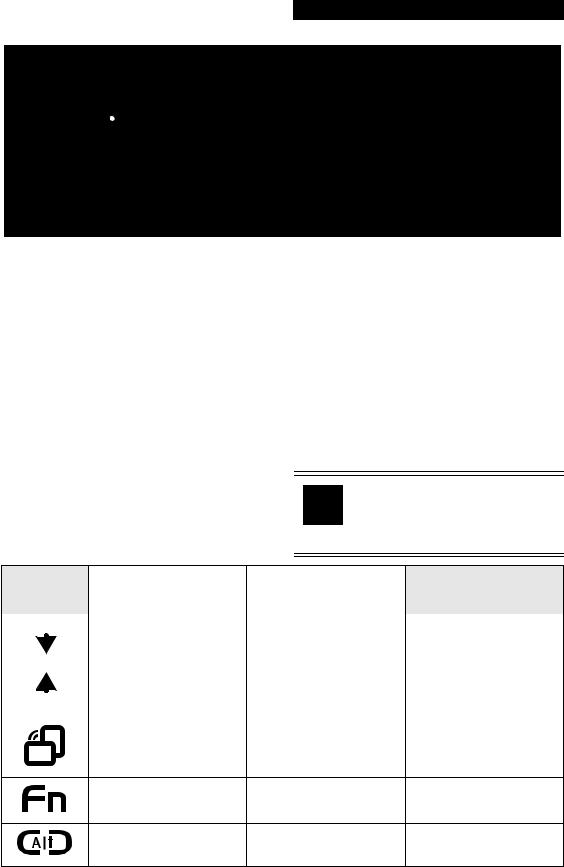
G e t t i n g t o K n o w Y o u r T a b l e t P C
(1) Application A Button
 (2) Application B Button
(2) Application B Button
(3) Button 3
(4) Button 4
Enter Button
Figure 2-18. LifeBook T Series Tablet PC Security/Tablet PC Buttons
LifeBook Security/
Tablet PC Buttons
A unique feature of your LifeBook T Series Tablet PC is the array of Security and Tablet PC buttons. These buttons allow you to secure your Tablet PC from unauthorized use and to launch specific applications with the touch of a button.
If the security system is activated, upon starting your Tablet PC or resuming from Standby, Hibernate, or shutdown mode the security system will require you to enter a password code using the security buttons. After you enter the correct password, your Tablet PC will resume operation.
The five security/Tablet PC buttons are located on the bottom right-hand side of the display when it is configured to be used as a notebook. (Figure 2-18)
Security functions: All five buttons are used when implementing security functions. Four of the buttons are used to enter the password, and the fifth is used as an Enter button. See the right-hand column of Table 2-2.
Tablet PC functions: All five of the buttons have primary functions. Four of the buttons have secondary functions when used as application buttons. The secondary functions are activated by pressing the Function (Fn) button while pressing the application button. See Table 2-2 for specific functions. The secondary func-
tions of the Application A and B buttons can be changed to launch any application. See “Changing Tablet PC Button Functions” on page 24
When the system is logging on or when it is locked (i.e., when you have the Logon or Computer Locked window showing on your desktop), the A and B buttons act as [Tab] and [Enter] keys, respectively.
|
|
|
|
|
|
Secondary Function |
Security Panel Function |
|
Button Icon |
Primary Function |
(Pre-boot and resuming |
||||||
(Fn + Button) |
||||||||
|
|
|
|
|
|
from suspend) |
||
|
|
|
|
|
|
|
||
|
|
|
|
|
|
|
|
|
|
|
|
|
|
Page Down |
User-defined Application A |
Security Button 1 |
|
|
|
|
|
|
||||
|
|
|
|
|
(Default = Calculator) |
|||
|
|
|
|
|
|
|
||
|
|
|
|
|
|
|
|
|
|
|
|
|
|
Page Up |
User-Defined Application B |
Security Button 2 |
|
|
|
|
|
|
(Default = MS Journal) |
|||
|
|
|
|
|
|
|
||
|
|
|
|
|
|
|
|
|
|
|
|
|
|
Screen Rotation |
VGA-Out |
Security Button 3 |
|
Secondary Function
Fujitsu Menu Utility Security Button 4
Selection
Ctl+Alt+Del Button |
None |
Security Enter Button |
Table 2-2. Security/Tablet PC Button Functions
23

L i f e B o o k T S e r i e s T a b l e t P C - S e c t i o n T w o
Page Down / Application A Button
When you press the Page Down button when the system is running, each press of the button will scroll the screen down one frame. This allows you to navigate quickly through large documents.
When you press the Fn button while you press then release the Page Down/Application A button, you will automatically start whichever program is assigned to the button. The default application for this button is Calculator.
See “Changing Tablet PC Button Functions” on page 24 to select a different application for this button.
Page Up / Application B Button
When you press the Page Up button when the system is running, each press of the button will scroll the screen up one frame. This allows you to navigate quickly through large documents.
When you press the Fn button while you press then release the Page Up/Application A button, you will automatically start whichever program is assigned to the button. The default application for this button is Microsoft Journal.
See “Changing Tablet PC Button Functions” on page 24 to select a different application for this button.
Screen Rotation / VGA-Out Button
The screen rotation feature would normally be used only when the system is configured as a tablet. When you would like to use the tablet as an eBook, for example, you would use the portrait orientation; when accessing spreadsheets or using the system as a notebook, you would more typically use landscape orientation.
When the system is changed to tablet configuration, the orientation automatically changes to portrait mode by default.
The screen orientation default can be changed by going to the Control Panel and double-clicking on the Fujitsu Display Control icon and selecting the desired defaults from the Display Orientation section. After changing the defaults, click [OK].
When you press the Screen Rotation / VGA-Out button, the system screen orientation changes from portrait (vertical) to landscape (horizontal) or from landscape to portrait.
Function / Fujitsu Menu Utility Button
The Function button works in conjunction with the other application buttons to provide additional functionality for the buttons. Refer to specific details above.
Pressing the Fn button twice in succession causes the Fujitsu Menu Utility to appear on your screen, allowing you to modify certain system settings.
Ctl+Alt+Del Button
Pressing and holding the Ctl-Alt-Del button for up to 750 msecs launches the Logon screen or the Windows Task Manager (if the system hasn’t yet been configured).
CHANGING TABLET PC BUTTON FUNCTIONS
The Application A and B buttons can be changed to launch a program or perform an action you select. By default, the Application A button launches the Calculator, and the Application B button launches MS Journal.
To launch different applications or cause the Application A or B buttons to perform a specific action:
1.Double-click on the Tablet and Pen Settings icon in the Control Panel.
2.Select the Tablet Buttons tab and select the button you would like to change from the list.
3.Click [Change] and open the drop down list in the Action: field.
4.Select the action you would like the button to perform. If you want to launch a program, click on Launch an Application then browse to the location of the program.
5.Click [OK], then click [OK] again. The buttons will now perform the actions you have assigned to them.
SETTING UP LIFEBOOK SECURITY PANEL
When you receive your Tablet PC, the security panel application is pre-installed without any passwords. The following sections provide detailed information on your security panel, how to set, change or remove passwords.
Numbered Buttons
Use these buttons to enter your password.(Figure 2-18)
Enter Button
After entering the button strokes, push this button to enter the password into the Tablet PC. (Figure 2-18)
PASSWORDS
The user and supervisor password may be set on this Tablet PC. A supervisor password is typically the same for all Tablet PC’s and notebooks in a work group, office, or company to allow for system management. Individual computers in a group environment should not use a common password. A password consists of one to five button strokes plus the enter button. A valid stroke consists of pushing one or up to four buttons simultaneously.
24
